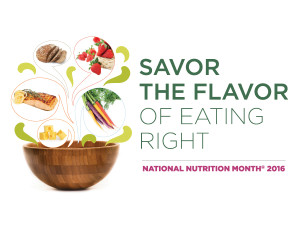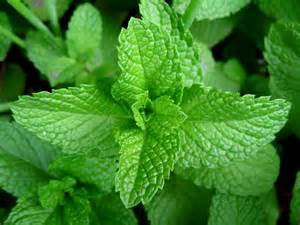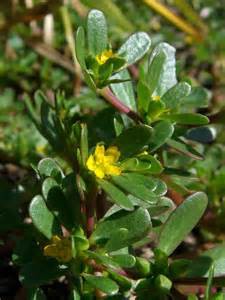 March is National Nutrition Month and this year the Academy of Nutrition and Dietetics’ theme is “Savor the Flavor of Eating Right.” They are encouraging Americans to eat less sodium, sugar, and saturated fat. In simpler terms that means less than 2300 mg of salt a day, less than 25 grams of sugar for women and less than 35 grams of sugar for men a day while consuming less than 10% of the daily intake from saturated fat.
March is National Nutrition Month and this year the Academy of Nutrition and Dietetics’ theme is “Savor the Flavor of Eating Right.” They are encouraging Americans to eat less sodium, sugar, and saturated fat. In simpler terms that means less than 2300 mg of salt a day, less than 25 grams of sugar for women and less than 35 grams of sugar for men a day while consuming less than 10% of the daily intake from saturated fat.
So what does that mean in terms of flavor? Some may ask, “Well, how do I make my food taste good now?” My answer is herbs and spices, which goes right along with this year’s theme. Herbs are the fresh or dried leaves of a plant, and spices are dried, ground parts of a plant, but do not involve the leaves. Herbs and spices are a great way to pack a big punch with flavor without all the negative benefits from added salt, sugar, and fat.
Here is my rundown of my favorite spices and herbs with benefits, and how to use them.
SPICES:
 Cinnamon: High in anti-oxidants, decreases blood pressure, and lowers blood glucose in diabetics. Use in oatmeal, coffee, and yogurt. I add a cut up apple to my oatmeal and stir in cinnamon.
Cinnamon: High in anti-oxidants, decreases blood pressure, and lowers blood glucose in diabetics. Use in oatmeal, coffee, and yogurt. I add a cut up apple to my oatmeal and stir in cinnamon.
Cumin: Aides in immunity, improves digestion, is rich in iron and Vitamin C, and has diabetes prevention properties. Use in soups, multi-cultural dishes, and fish dishes. It is also great sprinkled on sliced tomatoes. During my recent trip to Israel, cumin was used in most of the dishes I consumed.
Ginger : Useful in alleviating digestion issues, preventing inflammation, and has antioxidant properties. Use in vegetable dishes, fish dishes, and tea. I place fresh ginger in my water every day.
: Useful in alleviating digestion issues, preventing inflammation, and has antioxidant properties. Use in vegetable dishes, fish dishes, and tea. I place fresh ginger in my water every day.
A colleague of mine who is from Morocco uses a combination of onion powder, cumin, and ginger over meat, fish, rice, roasted potatoes, and cooked vegetables. It is so good!
See my previous blog, Pumpkin Spice and Other Fall Flavors, for more ideas on how to use spices to flavor your foods and beverages.
HERBS:
Basil: Reduces inflammation and fatigue, has anti-oxidants, and anti-aging properties. Use in pesto, pasta dishes, and salads. Plant basil in a small pot for your windowsill to enjoy all winter long.
Mint : Helpful with digestion (except those with GERD and stomach cancers), respiratory issues and coughs, and weight loss, because it stimulates digestion. Use fresh mint in water, sorbets, tea, and savory dishes. This is another great herb for the windowsill, which can then be used in your water year-round.
: Helpful with digestion (except those with GERD and stomach cancers), respiratory issues and coughs, and weight loss, because it stimulates digestion. Use fresh mint in water, sorbets, tea, and savory dishes. This is another great herb for the windowsill, which can then be used in your water year-round.
Purslane : Contains omega-3 fatty acids, and Vitamin A, C, and B-complex vitamins. Do not use if you are prone to kidney stones. It is usually seen as a weed in your backyard, but it can be used in foods such as Indian dishes, salads, and stews. I have not had great success with this on the windowsill, but I’m trying again this year.
: Contains omega-3 fatty acids, and Vitamin A, C, and B-complex vitamins. Do not use if you are prone to kidney stones. It is usually seen as a weed in your backyard, but it can be used in foods such as Indian dishes, salads, and stews. I have not had great success with this on the windowsill, but I’m trying again this year.
If you’re unsure of how to use a spice or herb, type it into a website like Eating Well, which will provide recipes based around ingredients or check out this herb and spice chart. Using herbs and spices you can add flavor to your food while eating right!
Happy National Nutrition Month!
Be Well,
Megan
Megan Carrier, MS
Eat Fit Health Intern